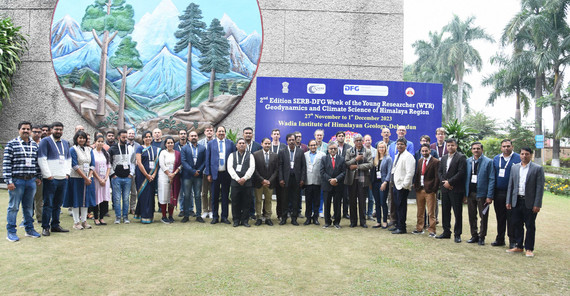There is a long tradition of research cooperation between India and Germany, which the German Research Foundation (DFG) and the Science and Engineering Research Board of the Indian government (SERB) intend to expand in the coming years – Germany is India's second largest scientific cooperation partner after the US. The event in Dehra Dun offered early-career researchers from both countries the opportunity to exchange research interests and expertise with the aim of establishing long-term research partnerships.
The workshop was attended by 10 German and 14 Indian geoscience researchers working at various academic institutions in their countries and covering a wide range of geoscientific expertise, including geology, mineralogy, sedimentology, and remote sensing.
High-ranking scientists from the University of Potsdam (Prof. Peter van der Beek, Prof. Bodo Bookhagen) and the University of Kiel (PD Dr. Rasmus Thiede) contributed to the scientific program and organized topics and discussions in their respective research areas. The central topics of the workshop included the complex seismic and sediment-related hazards in the Himalayas and the role of geosciences in quantifying and predicting them.
Dr. Akhilesh Gupta, Secretary of the SERB, who emphasized the potential of cooperation between Germany and India in the future, opened the workshop. The participants received information about funding opportunities for future collaboration projectss from representatives of funding organizations such as the SERB, the Indo-German Science and Technology Centre (IGSTC), the German Academic Exchange Service (DAAD), and the DFG.
The week-long program offered scientific discussions and symposia, as well as excursions to important geoscientific outcrops. The highlight was a visit to the Main Himalayan Thrust, the world's largest continental thrust structure, which absorbs 20 mm per year of relative movement between the Indian subcontinent and Eurasia. It is one of the most active seismic structures on earth, capable of causing earthquakes of magnitude 8 to 9, and has uplifted the Himalayas over the last few million years. Researchers from both countries discussed how the assessment of seismic hazards can be improved and how deformation measurements can be transferred into the past. Prof. van der Beek pointed out the potential of long-term uplift measurements based on rock temperature changes, which can be determined using geochemical methods in the laboratory facilities at the University of Potsdam.
A second widely discussed topic was the changes and increase in sediment transport in rivers. This leads to the filling of reservoirs and to a shortening of their lifespan, but also to an overall deterioration in water quality for biological habitats, agricultural use, and drinking water production. Dr. Smith from the University of Potsdam presented new remote sensing-based methods for measuring sediment concentration in rivers and discussed them during an excursion to the Tehri Dam. The Tehri Dam is the highest dam in India – and one of the highest in the world – and is used to generate energy with a 1000-MW hydropower plant. An increase in landslides and changes in the land cover upstream have led to the reservoir filling up at an increasing rate, necessitating expensive remediation measures. In addition, the reservoir is located near tectonically active faults and must be monitored in connection with earthquake-induced landslides and faults.
Since the first Indo-German Week of the Young Researcher took place in Delhi in 2022 with a focus on chemistry and with the second week now taking place in Dehra Dun, the participating researchers and the organizing team are planning a follow-up workshop and discussion in Germany next year.

